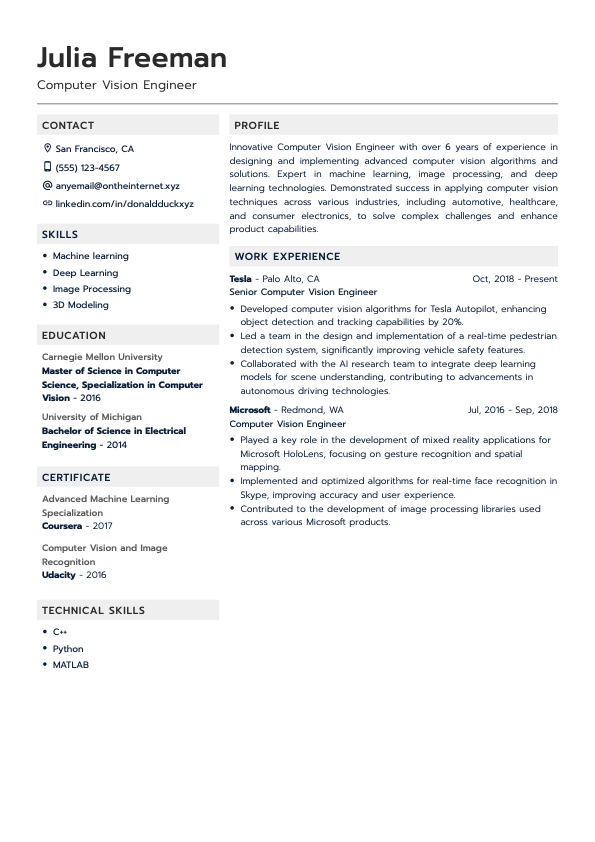
The role of a Computer Vision Engineer is projected to be one of the most sought-after skills in the next decade. Learn how to elevate your resume by effectively highlighting your skills and achievements to impress potential employers in the field of Computer Vision Engineering.

"Innovative and results-driven Computer Vision Engineer with over 5 years of experience specializing in developing advanced image processing and object recognition solutions. Expertise in leveraging machine learning and deep learning algorithms to enhance automation and accuracy in visual data analysis. Demonstrated success in leading projects that improved operational efficiencies across various industries, including automotive and healthcare. Proficient in Python, C++, and several deep learning frameworks. Passionate about merging technical skills with creative problem-solving to deliver products that challenge the boundaries of current technologies."
Tips for Writing a Strong Resume Summary
Keep it brief: Aim for 3-4 sentences, ideally between 50 – 100 words.
Focus on your most relevant experiences and achievements.
Incorporate keywords from the job description to align with the employer’s expectations.
- Led a team in developing a state-of-the-art facial recognition system, reducing identification errors by 25% and enhancing security measures for a high-profile client in the financial sector.
- Designed and implemented a real-time vehicle detection algorithm for an autonomous driving project that decreased detection time by 40% while maintaining 98% accuracy, contributing significantly to the project’s advance into its next development phase.
- Spearheaded the integration of computer vision technologies into a retail analytics platform, resulting in a 35% improvement in customer engagement by providing valuable insights into shopper behaviors and preferences, and thereby enabling personalized shopping experiences.
Best Practices for Experience Section
Use reverse chronological order, starting with your most recent role.
Include company names, job titles, and dates of employment.
Emphasize accomplishments that align with the job responsibilities.
Technical Skills
Soft Skills
Tips for Skills Section
Use bullet points for clarity and readability.
Tailor your skills to match the job description.
Prioritize the most relevant skills for this role
Tips for Including Courses and Certifications
Creating a professional resume doesn’t have to be daunting. With the right guidance and tools, you can craft a resume that captures your strengths and impresses hiring managers. Use the Careerpilot resume builder and explore our suggested resume templates to get started. With our intuitive platform, you’ll have a polished and customized resume in no time. Start building your resume today and take the first step toward your next career opportunity!
We use cookies to enhance your experience. By continuing to visit this site, you agree to our use of cookies. Not consenting or withdrawing consent, may adversely affect certain features and functions.